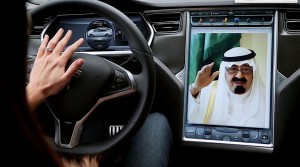The decision by the government of Saudi Arabia to lift its long-standing ban on female drivers is expected to add 60,000 units per year in new vehicle sales in the oil-rich kingdom, according to IHS Markit’s forecast for 2019 to 2030.
Saudi King Salman bin Abdulaziz Al Saud issued a royal decree last week allowing women to drive on the kingdom’s roads starting June 2018. A committee has been set up to study the issue, and it is due to advise the government within 30 days on how to enforce the royal order.
The King’s decision creates an opportunity for the automotive sector and by opens up an entirely new market for automakers both in the short- and long-term, IHS said.
IHS Markit forecasts that the removal of the driving ban, along with an improvement in medium-term oil prices, will play an important role in lifting the kingdom’s light-vehicle sales to more than 850,000 units by 2021–22.
(Toyota eyes building auto plant in Saudi Arabia. For the story, Click Here.)
The Middle East has become an important export market for U.S. manufacturers thanks to demand for sport utility vehicles. American pick-up trucks are also popular but European luxury carmakers also have expanded their sales in Saudi Arabia and other countries in the region.
The Saudi vehicle market has struggled in recent years, with light-vehicle sales having declined by 12.2% in 2016 to 706,100 units. The high cost of living, a reduction in government subsidies, and low oil prices eventually leading to declining consumer confidence are some of the main factors behind the slump in automotive sales.
As these headwinds are not short term, the government has resorted to increasing taxes, which in turn has forced consumers to save more and spend less. In the first seven months of 2017, automotive sales totaled around just 300,000 units, a 28% year-on-year decline, IHS noted in its analysis of the automotive market in Saudi Arabia.
However, IHS said the decision to allow women to drive is likely to release fresh demand in the market and provide an opportunity for the automotive sector in the short and long term.
“Currently, Saudi women spend the bulk of their salaries on drivers or else they must be driven to work by male relatives. The removal of the ban effectively opens up an entirely new market for automakers,” the report said.
Nevertheless, IHS Markit estimated that the boost to new vehicle sales could be less than what might be expected on first sight.
(Senate clears last roadblock, allow widespread testing of autonomous vehicles. Click Here for the story.)
Although the female population in the country is estimated at around 14 million, the female market for automakers is limited to 6.5 million women in the age group 20–49 years. A large part of the potential demand is already met by an army of private drivers, taxis, and ride-hailing services such as Uber and Careem, IHS noted.
“Given that Saudi Arabia is the only country in the world that currently does not allow women to drive, the decision is seen by many as paving the way for female empowerment in the kingdom. Like most social changes, it will have several implications for the economic and business landscape of the country, especially the automotive sector,” the report said.
Although there is no formal law banning female drivers in Saudi Arabia, the government has not issued a license to a woman since 1990 when a religious fatwa issued by clerics prohibited women from driving in the country.
Nevertheless, it is expected that sedans and SUVs will gain the most as these body types have traditionally been favored by Saudi buyers.
According to data available with IHS Markit, C- and D-segment cars were the most popular vehicle categories with Saudi buyers in 2016, accounting for 26.1% and 19.6%, respectively, of total light-vehicle sales in the country.
(To see more about Cummins building the next-gen Advanced Combat Engine, Click Here.)
“We forecast that the removal of the driving ban, along with an improvement in medium-term oil prices, will play an important role in lifting the kingdom’s light-vehicle sales to more than 850,000 units by 2021–22,” IHS said.


Should also grow their body shop business.